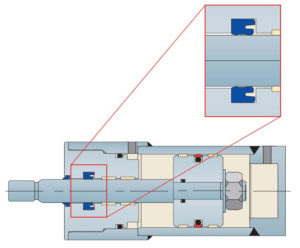
The rod seal is one of the most critical seals on any type of fluid power equipment. The rod seal prevents the pressurized hydraulic fluid within the cylinder from leaking. Leakage can lead to reduced equipment performance, system failure, and environmental/safety issues.
As illustrated at right, rod seals are dynamic seals that are positioned inside the cylinder head (also called gland) and compressed against the cylinder’s rod, thus containing the fluid, which allows pressure to be generated. Some rod seals are engineered specifically for demanding applications that are subject to extreme and arduous operating conditions. These designs are commonly found in medium- to heavy-duty construction, off-highway, excavating and mining equipment. Rod seals designed for low-friction and/or high-speed operating conditions can be found in pumps and engine bearings.
Since rod seals are available in a variety of high-performance materials to suit a wide range of operating conditions, temperature, and fluid requirements, the material required will influence the choice of seal design. It is important to select the correct material and profile of the rod seal to align with the application’s requirement.
Consider for example the Hallite RDS—a double-acting low-friction Armorlene PTFE rod seal solution for compact O-ring grooves. The PTFE material and design extends the service range above what an O-ring alone can support and makes the seal particularly suited for light-duty applications and small-diameter installations.
For the best sealing performance and to ensure optimal operation, rod seals are paired with an appropriate wiper/scraper to prevent contamination from entering the system. For example, if a rod seal is paired with an aggressive wiper, the wiper can scrape off the thin film of oil that remains on the rod in microscopic surface imperfections during the return stroke after the rod passes through the rod seal. This creates a second layer of protection. Contamination is the most common reason for hydraulic system failure.
If a system leak exists, the rod seal is one of many potential causes. Consulting with an experienced seal engineer is a prudent action to determine if the issue is due to the rod seal design, material selection, system/gland design, or a multitude of different scenarios
Contributed by Ryan Webster, Director of Engineering, Hallite Seals International.


Leave a Reply